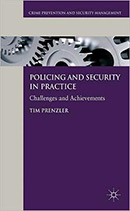Policing and Security in Practice: Challenges and Achievements

Editor: Tim Prenzler, ed.
Publisher: Basingstoke, UK; New York: Palgrave Macmillan, 2012. 256p.
Reviewer: Walter Campbell | March 2013
Practitioner involvement in criminal justice research is a key and often missing element in effective reform. In his preface, editor Tim Prenzler affirms that one of the main goals of his collection on policing and security is broad applicability achieved through text that appeals to both researchers and practitioners. That goal is well met through the breadth of topics covered and the authors’ clarity and brevity in discussing those topics, making this a text with significant potential.
One way in which the goal of broad applicability is met is through the range of topics covered. Topics relating to policing cover the management of a police force with chapters on subjects such as measuring police performance, problems with police legitimacy, integrating intelligence into policing, police leadership, and police corruption. The chapters on policing also cover specific issues faced by police, such as organized crime, protests, and traffic violations. The range of topics covered is further expanded by the inclusion of private security, the importance of which is best illuminated in Chapter 9, which discusses the role that private-public partnerships can play in successful crime prevention. The examination of security continues with chapters on officer safety in policing and security, security technology, and regulation of the security industry. And even though all the authors work in Australia, its international applicability in no way suffers from this, as the topics discussed are relevant to policing and security in all countries.
The goal of broad applicability is also met through the clarity and brevity of the writing. Each chapter outlines a topic, discusses the issues surrounding it, and supplies some practical solutions, while by no means skipping over interesting research. In doing so, each chapter functions both as an effective guide for the practitioner and an intellectually intriguing read for the academic. The practicality of the solutions offered varies by chapter, but that is more a product of the topics at hand than the authors covering them. For example, the complexity and variety of organized crime does not lend itself to simple solutions. One the other hand, ideas to increase the integration of intelligence in policing are more easily discovered (although perhaps not so easily applied), and thus a much simpler plan of action accompanies that chapter. But in spite of these challenges, all chapters provide potential solutions, even those addressing the most nebulous and elusive of topics.
A key take away from the book—and from each chapter within it—is the very reason such a book is necessary: there is still a long way to go. While certainly true for policing, this is even truer for security, which at the moment is quite under-researched and under-regulated. The gaps between actual practice and best practice in policing and security make it all the more important that this book is, as Prenzler says, “designed to appeal to a wide readership, including academics, students of policing and security, managers and operational officers in both fields and legislators and policy makers.” Thus the value of this book lies in its power to inform a variety of professions in the same field, which is an essential step towards effecting real change within policing and security.
Walter Campbell, Graduate Student, University of Pennsylvania.


